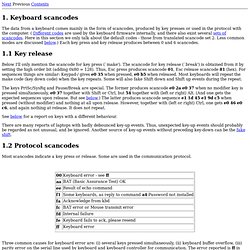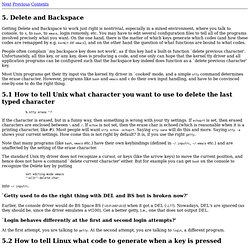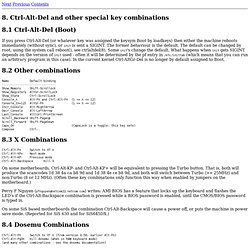

Get Key Press - Python. Linux - checking if a key was pressed. C - How to get keyboard state in Linux. Configure unrecognized keys in Linux - Juan Valencia's website. Occasionally I am presented with keyboards that contain keys that are not recognized by default in Linux.

In most cases the fix consist in select a different keyboard layout, modern Linux distributions cover a wide variety of keyboards, but some times there is no keyboard layout available that matches our keyboard and the functionality of some keys is lost. In this post I write about how to detect and map unrecognized keys. I am making the assumption that you are working in a graphical environment and that you want to give it some functionality to the key there. TopicsWhat happens when we press a key? Obtaining the scan code of unrecognized keysAssing a key code to the scan codeMake a script that runs at boot time What happens when we press a key? When we press a key, a scan code is send from the keyboard to the system, the kernel reads this scan code and try to find it in a table that maps this scan codes, the number associated with the scan code in this table is called a key code.
. #! Extra Keyboard Keys. Keyboard scancodes: Keyboard scancodes. Next Previous Contents 1.

Keyboard scancodes The data from a keyboard comes mainly in the form of scancodes, produced by key presses or used in the protocol with the computer. ( Different codes are used by the keyboard firmware internally, and there also exist several sets of scancodes. Here in this section we only talk about the default codes - those from translated scancode set 2.
Less common modes are discussed below.) 1.1 Key release Below I'll only mention the scancode for key press (`make'). The keys PrtSc/SysRq and Pause/Break are special. See below for a report on keys with a different behaviour. There are many reports of laptops with badly debounced key-up events. 1.2 Protocol scancodes Most scancodes indicate a key press or release. Three common causes for keyboard error are: (i) several keys pressed simultaneously, (ii) keyboard buffer overflow, (iii) parity error on the serial line used by keyboard and keyboard controller for communication. 1.3 Escape scancodes. Linux and the keyboard. Table of keyboard shortcuts. In computing, a keyboard shortcut is a sequence or combination of keystrokes on a computer keyboard which invokes commands in software.

Some keyboard shortcuts require the user to press a single key or a sequence of keys one after the other. Other keyboard shortcuts require pressing and holding several keys simultaneously (indicated in the tables below by this sign: +). Keyboard shortcuts may depend on the keyboard layout (localization). Comparison of keyboard shortcuts[edit] Keyboard shortcuts are a common aspect of most modern operating systems and associated software applications. General shortcuts[edit] A note regarding KDE's shortcuts is that they can be changed and the below list contains the defaults. [edit] Power management[edit] Screenshots[edit] Text editing[edit] Many of these commands may be combined with ⇧ Shift to select a region of text.
C key pressed in Linux console. The Linux keyboard and console HOWTO: Delete and Backspace. NextPreviousContents 5.

Delete and Backspace Getting Delete and Backspace to work just right is nontrivial, especially in a mixed environment, where you talk to console, to X, to bash, to emacs, login remotely, etc. You may have to edit several configuration files to tell all of the programs involved precisely what you want. On the one hand, there is the matter of which keys generate which codes (and how these codes are remapped by e.g. kermit or emacs), and on the other hand the question of what functions are bound to what codes. People often complain `my backspace key does not work', as if this key had a built-in function `delete previous character'. Most Unix programs get their tty input via the kernel tty driver in `cooked' mode, and a simple stty command determines the erase character. 5.1 How to tell Unix what character you want to use to delete the last typed character % stty erase ^?
If the character is erased, but in a funny way, then something is wrong with your tty settings. Put. The Linux keyboard and console HOWTO: Ctrl-Alt-Del and other special key combinations. NextPreviousContents 8.

Ctrl-Alt-Del and other special key combinations 8.1 Ctrl-Alt-Del (Boot) If you press Ctrl-Alt-Del (or whatever key was assigned the keysym Boot by loadkeys) then either the machine reboots immediately (without sync), or init is sent a SIGINT. The former behaviour is the default. 8.2 Other combinations Name Default binding ------------------------------- Show_Memory Shift-Scrollock Show_Registers AltGr-ScrollLock Show_State Ctrl-ScrollLock Console_n Alt-Fn and Ctrl-Alt-Fn (1 <= n <= 12) Console_{n+12} AltGr-Fn (1 <= n <= 12) Incr_Console Alt-RightArrow Decr_Console Alt-LeftArrow Last_Console Alt[Gr]-PrintScreen Scroll_Backward Shift-PageUp Scroll_Forward Shift-PageDown Caps_On (CapsLock is a toggle; this key sets) Compose Ctrl-. 8.3 X Combinations.